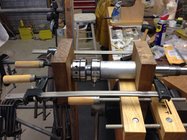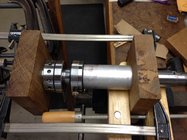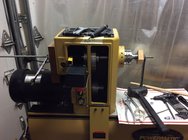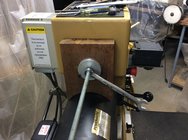A friend has a Powermatic lathe ( I think it is a 42 something). he needs to replace the belt. The owner's manual and U -Tube are of no help. Anyone know how to do this. Thanks
-
It's time to cast your vote in the December 2025 Turning Challenge. (click here for details) -
Congratulations to Pat White for "Sicilian Mosaic" being selected as Turning of the Week for December 29, 2025 (click here for details) -
Welcome new registering member. Your username must be your real First and Last name (for example: John Doe). "Screen names" and "handles" are not allowed and your registration will be deleted if you don't use your real name. Also, do not use all caps nor all lower case.
You are using an out of date browser. It may not display this or other websites correctly.
You should upgrade or use an alternative browser.
You should upgrade or use an alternative browser.
belt replacement
- Thread starter Paul M. Kaplowitz
- Start date
I have removed the spindle from my 3520 3-4 times. The 4224 should be similar. I use 3/8" all-thread through the spindle and wood blocks to remove and replace it or in other words, pull it out and pull it back in place. "F clamps", wood blocks and an aluminum sleeve are used to pull the new bearings on the spindle. I have a few photos of the setup replacing the bearings and reinstalling the spindle, none for removing spindle and bearings from the spindle shaft. Will post photos later.
Tom Gall
TOTW Team
How about a link belt. Avoids the hassle of pulling the spindle/bearing assembly. I did this on my General 260 about 15 yrs. ago - works fine. Only problem on my General with a 4-step pulley is trying to change the belt to the largest pulley - not enough room between the pulley and the headstock casting is a chore. But I rarely use that pulley anyway.A friend has a Powermatic lathe ( I think it is a 42 something). he needs to replace the belt. The owner's manual and U -Tube are of no help. Anyone know how to do this. Thanks
The multi web v belts used ( similar to the serpentine belts used in automobiles) cannot be replaced with a link belt.How about a link belt. Avoids the hassle of pulling the spindle/bearing assembly. I did this on my General 260 about 15 yrs. ago - works fine. Only problem on my General with a 4-step pulley is trying to change the belt to the largest pulley - not enough room between the pulley and the headstock casting is a chore. But I rarely use that pulley anyway.
Tom Gall
TOTW Team
My bad! My lathe is 26 years old ... guess today's lathes don't use V-belts anymore!The multi web v belts used ( similar to the serpentine belts used in automobiles) cannot be replaced with a link belt.
I pulled the spindle using 3 blocks of "Iron Wood" to make a bridge at the headstock for clearance for pulling the spindle. with the all-thread. No pictures.
The first set of Nachi Bearings (made in Japan) were a very tight fit on the spindle. The "F" clamps are bowed from the force required. The hose clamp on the inner bearing is holding the bearing spacer in position. The section of aluminum is pressing on the inner bearing race. The bearing spacer only contacts the outer race of the pair of bearings. The extremely tight fit of the inner bearing race resulted in a bearing preload between the pair of bearings. The bearings ran warm and after 6 months of trying various things I pulled the spindle and put in new, special order, SKF bearings. One of the SKF Bearings was labeled "Made in Bulgaria". The takeaway, the inner bearing race needs to be able to move on the spindle w/o a lot of force or there will be a fixed preload that can't be adjusted out. The SKF bearings were not a problem.
About 2 years ago I replaced the belt and put in new Nachi bearings. I didn't notice until I got home, Made in India. No problems so far.
The first set of Nachi Bearings (made in Japan) were a very tight fit on the spindle. The "F" clamps are bowed from the force required. The hose clamp on the inner bearing is holding the bearing spacer in position. The section of aluminum is pressing on the inner bearing race. The bearing spacer only contacts the outer race of the pair of bearings. The extremely tight fit of the inner bearing race resulted in a bearing preload between the pair of bearings. The bearings ran warm and after 6 months of trying various things I pulled the spindle and put in new, special order, SKF bearings. One of the SKF Bearings was labeled "Made in Bulgaria". The takeaway, the inner bearing race needs to be able to move on the spindle w/o a lot of force or there will be a fixed preload that can't be adjusted out. The SKF bearings were not a problem.
About 2 years ago I replaced the belt and put in new Nachi bearings. I didn't notice until I got home, Made in India. No problems so far.
Attachments
- Joined
- Jan 27, 2005
- Messages
- 13,188
- Likes
- 5,768
- Location
- Dalworthington Gardens, TX
- Website
- pbase.com
I would recommend The Belt Store (https://www.beltsforanything.com) in Lafayette, Louisiana for the best price and great service. Today, most lathes use J-section belts (also known as multi-ribbed or poly-ribbed belts).
The motor bearings I put in my 3520B motor were SKF, made in India. I did a search and it appears SKF many years ago started three bearing plants there as well as many other countries. I have concerns about the bearings I put on the spindle, bought them locally but not SKF, to me they were not tight enough on the shaft nor in the headstock. I watched a video of someone changing their bearings on a Jet lathe and I was amazed how loose those bearings were. I can;t remember the name of the company that produced those lathes but it is or was when my lathe was made the same company. My bearings were fine until I washed the grease out of some of them when cleaning inside the headstock with PB Blaster. The new bearings went in as loose (to me) as the original came out but appears to be okay. I've roughed in three pecan bowls since the bearing change out and the bearings seem fine, see no grease easing out on the ones I cannot touch, time will tell.
A key reason why I like my Nova XPD2....no belts!
Well, many years ago, my 3520A bearings gave out during a month long Christmas show. I went to Kaman Bearings who had a local store, got new bearings and a new belt. Took the headstock to a local repair place, and they fixed it for me for less than I could get the parts for through Jet, and this included parts and labor. Some of the lathes like Robust and Oneway have a removable headstock spindle so you don't have to take the bearings out to replace the belt, at least in theory. I haven't tried that yet. Oh, you can remove the motor before you take the headstock in for repairs.
robo hippy
robo hippy
- Joined
- Jan 27, 2005
- Messages
- 13,188
- Likes
- 5,768
- Location
- Dalworthington Gardens, TX
- Website
- pbase.com
The motor bearings I put in my 3520B motor were SKF, made in India. I did a search and it appears SKF many years ago started three bearing plants there as well as many other countries. I have concerns about the bearings I put on the spindle, bought them locally but not SKF, to me they were not tight enough on the shaft nor in the headstock. I watched a video of someone changing their bearings on a Jet lathe and I was amazed how loose those bearings were. I can;t remember the name of the company that produced those lathes but it is or was when my lathe was made the same company. My bearings were fine until I washed the grease out of some of them when cleaning inside the headstock with PB Blaster. The new bearings went in as loose (to me) as the original came out but appears to be okay. I've roughed in three pecan bowls since the bearing change out and the bearings seem fine, see no grease easing out on the ones I cannot touch, time will tell.
Bearings should fit snug or tight on either the inside or outside, but not both. SKF (USA) bearings are among the top of all bearing manufacturers. Tightness is not an indicator of quality. Tighter bearings are usually for precision slow-speed operation. Bearings for motors and rotating machines like lathes that run at high speed have a moderate amount of looseness.
- Joined
- Jan 27, 2005
- Messages
- 13,188
- Likes
- 5,768
- Location
- Dalworthington Gardens, TX
- Website
- pbase.com
Some of the lathes like Robust and Oneway have a removable headstock spindle so you don't have to take the bearings out to replace the belt, at least in theory. I haven't tried that yet. Oh, you can remove the motor before you take the headstock in for repairs.
I've removed the spindle on my Robust several times. It's a simple job ... just remove the eight bolts that mount the bearing housing to the headstock casting. Why? Engineers don't need a reason to take things apart.
Removing the motor before taking the headstock anywhere is a very good idea. Here is a tip for Robust AB owners for attaching the motor to the headstock. I wasn't having any success trying to hold the motor steady with one arm while reaching around the headstock with the other hand and feeling around (in the blind, of course) for a bolt hole to fasten the motor to the headstock. I could hold the motor in position or I could put a bolt in a hole. but not both at the same time. I solved the problem by putting wooden dowels in three of the four mounting holes in the motor's C-face. That made it much easier to install a bolt in the open hole. Next, remove one of the dowels, and install a bolt. etc. It is also very nice to have a hydraulic table to help hold the motor.
A friend of mine was contemplating a Oneway purchase so I took him on a tour of the lathe assembly facility. I asked Kevin about how to change a belt and he had one of the assemblers come over and proceed to remove and replace a belt on one of the finished lathes. Took him less than 10 min. for the whole process. Al bought a Oneway 6 months later.Oneway have a removable headstock spindle so you don't have to take the bearings out to replace the belt,
Paul, I'd love to add a write-up on this to the Mustard Monster site.




